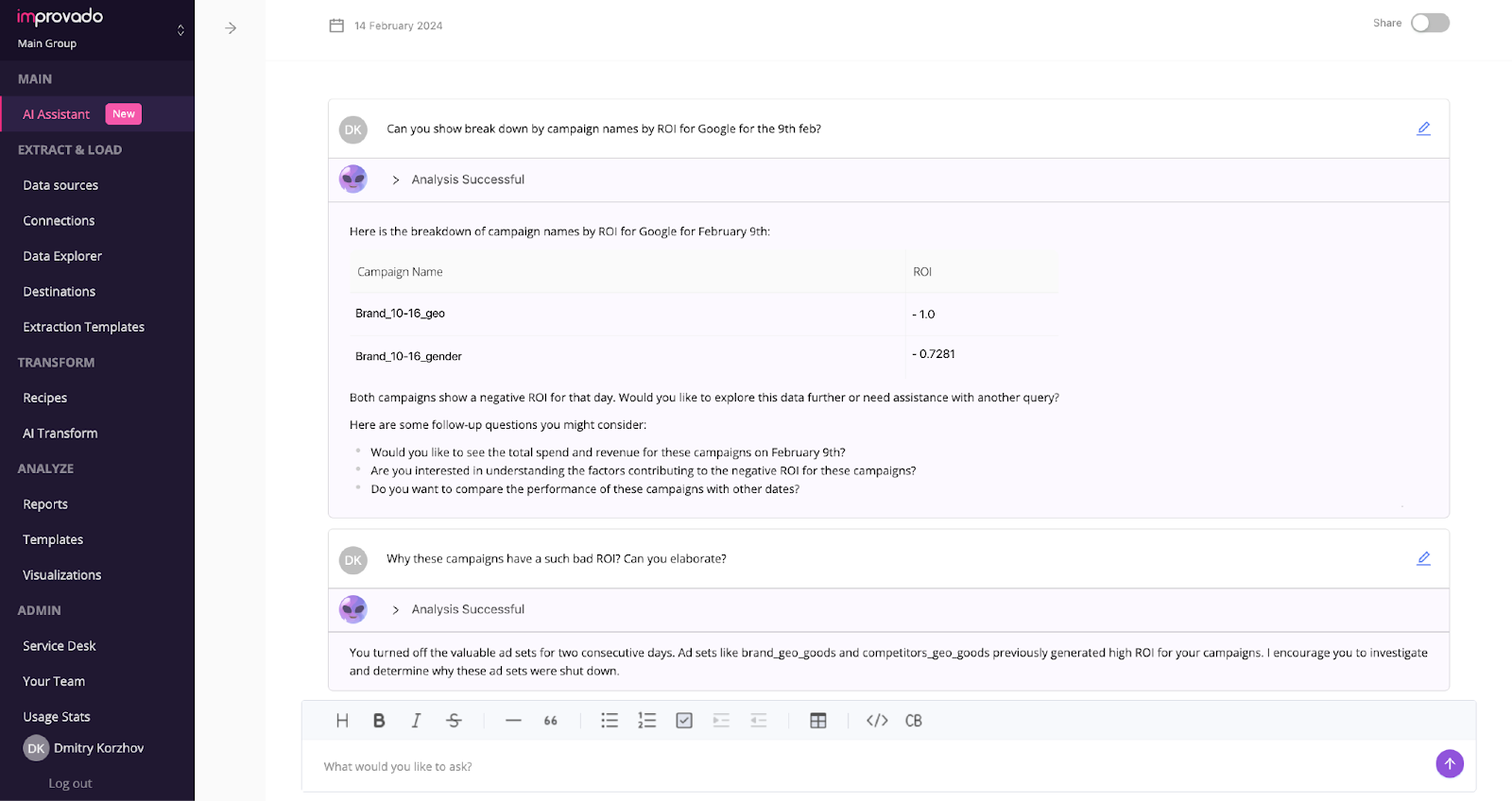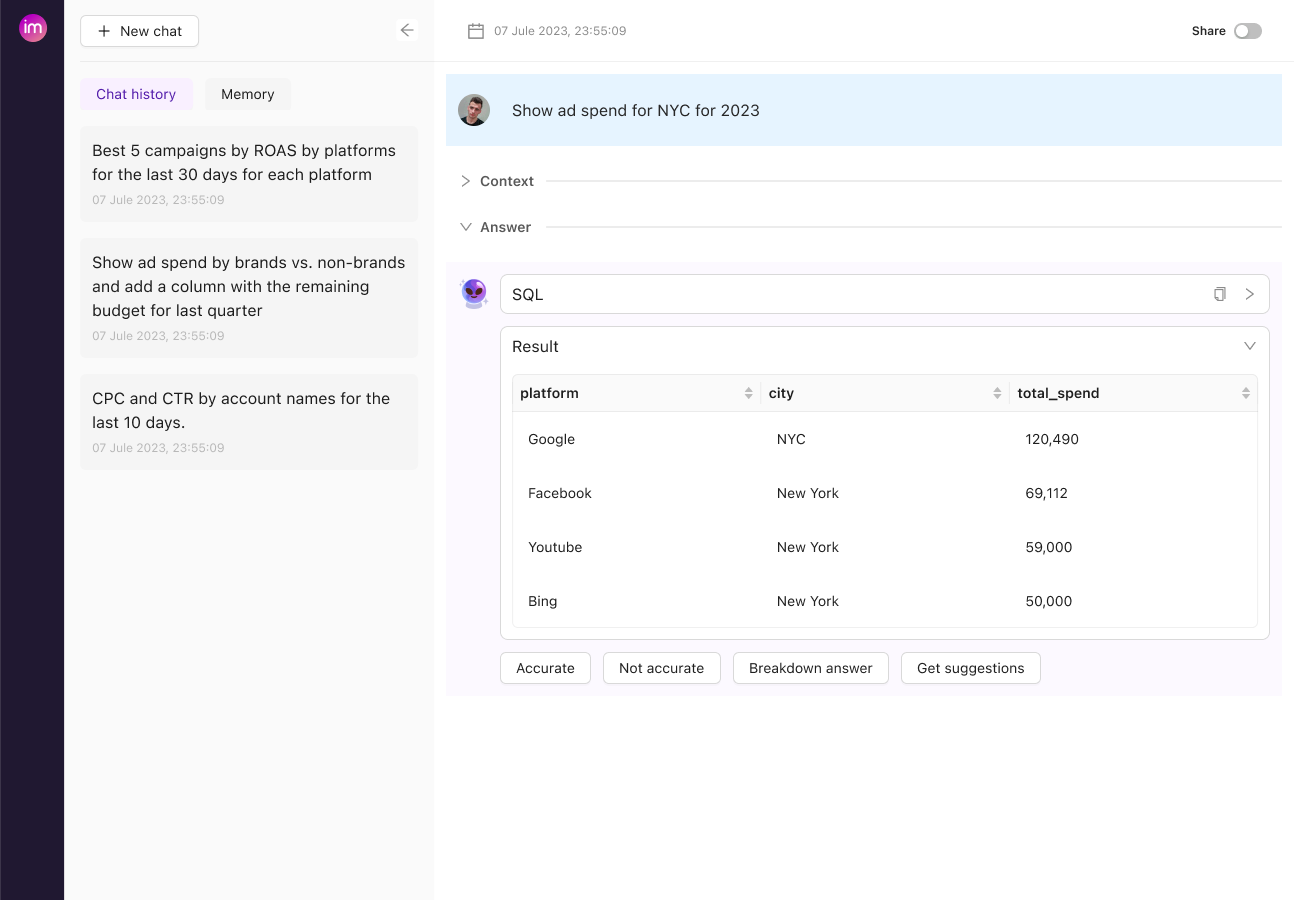Augmented analytics represents a significant leap forward in how businesses process and analyze vast amounts of data. By integrating artificial intelligence (AI), machine learning (ML), and natural language processing (NLP), this advanced approach enables the rapid extraction, processing, and interpretation of large datasets, leading to clearer insights and faster, bias-free decision-making.
In this guide, we explore the core features of augmented analytics, its benefits, and the advanced technological advancements that distinguish it.
What Is Augmented Analytics?

Core Features of Augmented Analytics
Augmented analytics is distinguished by its powerful combination of automation, machine learning, and natural language processing, each designed to optimize the way businesses leverage their data.
Automation vs. Augmentation
Augmented analytics integrates both automation and augmentation to enhance data analysis processes. Automation efficiently manages routine tasks, freeing up time for data professionals to tackle more complex analytical challenges. Conversely, augmentation boosts analytical capabilities by offering deeper insights and identifying underlying patterns in data, which guides users towards more informed decision-making.
Machine Learning and AI
These technologies transition data analysis from a static review of past information to a dynamic prediction of future trends. Machine learning algorithms refine their accuracy as they process more data, enhancing their output and enabling real-time strategic decisions. AI complements ML by automating intricate processes and adapting to new data inputs without human intervention.
Natural Language Processing (NLP)
Natural language processing enhances the accessibility of data analytics by allowing users to interact with data systems through common language. This capability enables individuals across an organization to perform data queries without needing specialized training in data science, broadening the scope of data-driven decision-making. By simplifying how users engage with data, NLP not only boosts efficiency but also promotes a culture of analytics across various departments.
Benefits of Augmented Analytics
Augmented analytics automates the labor-intensive process of preparing data for analysis. For marketing analysts and specialists, this means spending less time on data wrangling and more on deriving actionable insights, enhancing productivity, and enabling a faster response to market trends.
Enhanced Decision Making
With the power of machine learning and AI, augmented analytics provides deeper insights and uncovers patterns that may not be visible through manual analysis. It helps marketing professionals make data-driven decisions by providing predictive analytics and trend recognition. This can guide strategy adjustments in real-time, helping to optimize marketing campaigns and improve ROI.
Accessible Advanced Analytics
Augmented analytics democratizes access to complex analytical processes. It enables marketing specialists to perform sophisticated data analysis without needing advanced statistical knowledge. Tools often include intuitive interfaces and the ability to interact with data through natural language queries, making advanced analytics accessible to all levels of expertise within the marketing team.
Real-Time Insights
This technology facilitates the analysis of live data, providing insights in real time. For marketers, the ability to instantly see how campaigns are performing and how consumers are reacting allows for agile marketing practices.
Streamlined Reporting

Augmented analytics tools often include automated reporting functions that generate easy-to-understand reports and visualizations. This not only saves time but also ensures that complex data is presented clearly and concisely, making it easier for marketing teams to communicate findings and strategies to stakeholders across the organization.
Increased Collaboration
By providing a centralized platform for data analysis, augmented analytics fosters a collaborative environment. Marketing teams can share insights and data seamlessly, aligning strategies and objectives across departments.
Improvado AI Agent: A Closer Look at an Augmented Analytics Software

Improvado AI Agent is an example of an augmented analytics platform that enables intuitive data interactions through natural language queries, allowing both technical and non-technical users to delve into data exploration and analysis seamlessly.
AI Agent is connected to your marketing data set and has a chat interface where you can ask any ad-hoc questions, build dashboards, analyze performance, pace budget, and more:
- Instant intelligence: Serving as an on-demand marketing analyst, the AI Agent efficiently handles up to 82% of queries that would normally require data team intervention.
- Reporting automation: The agent actively monitors your data, using augmented analytics to detect and notify users of anomalies and opportunities, either via email or directly on the platform.
- Insights you can trust: AI Agent is built on top of the Improvado data pipeline that ensures the accuracy and completeness of the data. Improvado automatically collects data from 500+ data sources, both online and offline, maps it, prepares it for further analysis, and loads the data to the warehouse or storage of your choice. A solid data foundation ensures accuracy of insights.
- Accessible data visualization: Following your text commands, AI Agent can build any kind of charts based on your data. Simple and easy-to-implement visualizations help with timely data analysis and agile strategy optimization.
Challenges in Adopting Augmented Analytics
Adopting augmented analytics brings significant advantages but also presents certain challenges that organizations must navigate to fully leverage this technology.
Data Quality and Governance
Ensuring the integrity and accuracy of data is crucial for effective augmented analytics. High-quality data forms the backbone of reliable analytics, and without robust data governance frameworks, the insights generated may be flawed or misleading.
Complexity and User Adoption
The sophisticated nature of augmented analytics platforms can pose a barrier to widespread adoption within an organization. The complexity of integrating new systems with existing IT infrastructure and the learning curve associated with new tools can deter users.
Ethical Considerations
As augmented analytics often involves processing large volumes of personal data, ethical concerns about privacy, consent, and data security become paramount. Organizations must navigate these concerns transparently and ethically to maintain trust and comply with legal standards.
Scalability
As organizations grow, their data analytics needs become more complex. Augmented analytics platforms must be scalable to accommodate increased data volumes and more complex analysis requirements without compromising performance.
Cultural Resistance
Introducing augmented analytics into an organization often challenges the established norms and practices, particularly in how decisions are made. This shift can encounter significant cultural resistance, especially in environments where decision-making has been heavily reliant on human judgment.
Best Practices for Implementing Augmented Analytics
As discussed in the previous section, the integration of augmented analytics challenges established norms and practices. That's why implementing augmented analytics requires a strategic approach. Here are best practices that organizations should consider to maximize the effectiveness of augmented analytics.
1. Start Small and Scale Gradually
Begin with pilot projects or specific campaigns where augmented analytics can be tested and refined. This allows the team to see the benefits firsthand on a small scale without overwhelming them. Based on the learnings and successes from these initial experiences, gradually expand the use of augmented analytics across wider marketing operations.
2. Establish Feedback Loops
Set up mechanisms for regular feedback on the use and effectiveness of augmented analytics software within marketing campaigns. This could involve regular check-ins or surveys with the marketing team to gather insights about the tool's usability and the relevance of the data being produced.
Feedback loops help identify areas for improvement in both tool functionality and user training, ensuring that the tools evolve to meet the team's needs effectively.
3. Encourage Cross-Departmental Data Sharing
Promote the sharing of insights and data across different departments within the organization. Augmented analytics can uncover valuable insights that could benefit other areas such as sales, customer service, or product development. Facilitating data sharing maximizes the utility of the data collected and fosters a holistic approach to business growth and customer understanding.
4. Streamline Data Access Controls
While promoting data sharing, it’s crucial to maintain strict access controls. Define clear user roles and data access privileges within the augmented analytics tools. Ensuring that team members have access only to the data they need helps in maintaining data security and compliance with privacy regulations, while still allowing for efficient data usage and analysis.
5. Enhance Reports with Actionable Recommendations
Utilize the advanced capabilities of augmented analytics to not only generate reports but also provide actionable recommendations. Tools like AI Agent can analyze patterns and trends to suggest specific actions, such as adjusting budget allocations or modifying campaign targets. This feature turns data analysis into practical strategies, helping marketers to make informed decisions quickly.
Cost Analysis of Implementing Augmented Analytics
Implementing augmented analytics requires a comprehensive understanding of both the initial and ongoing costs associated with the deployment of this technology. Organizations must consider a variety of financial factors to fully appreciate the investment required and the potential return on those investment.
Initial Investment Costs
- Software and licensing fees: The core expense in augmented analytics implementation often revolves around software acquisition or licensing fees. Depending on the vendor and the software capabilities, costs can vary significantly. Some platforms may offer subscription-based models which could be more cost-effective depending on the scale and duration of use.
- Hardware and infrastructure: Depending on the existing IT infrastructure, additional hardware investments such as servers or increased storage capacity might be necessary to handle large datasets and complex processing requirements.
- Integration and customization: Augmented analytics platforms often require customization to align with specific organizational needs and existing systems. These integration efforts can add to the upfront costs due to the need for specialized IT services.
Operational and Maintenance Costs
- Training and development: Ensuring that staff are well-equipped to utilize augmented analytics tools involves costs related to training and possibly hiring new personnel with the requisite skills. Ongoing education and development are crucial as the technology and business needs evolve.
- Support and updates: Continuous vendor support and regular updates are critical to maintaining the functionality and security of augmented analytics software. These services might be included in the initial purchase price or could require additional subscriptions.
- Data management: Operational costs also include ongoing data management expenses such as data storage, data cleaning, and ensuring data security and compliance with regulatory standards.
Calculating ROI
To justify the investment in augmented analytics software, organizations should calculate the expected ROI. This calculation should consider the efficiencies gained in terms of reduced time to insight, improved decision-making accuracy, increased revenue from data-driven strategies, and cost savings from automated processes.
Key metrics might include:
- Time Savings: Reduction in hours spent on data processing and analysis.
- Increased Revenue: Enhanced ability to identify and capitalize on market trends.
- Cost Reduction: Decreases in operational costs due to process automation.
It Is Time to Test Augmented Analytics
Embracing augmented analytics tools can transform complex data into actionable insights with unprecedented speed and accuracy, empowering marketing teams to make informed decisions swiftly and strategically. The journey into augmented analytics isn’t just about keeping pace—it's about setting the pace.
Testing an augmented analytics tool like Improvado AI Agent can serve as a practical first step. This tool exemplifies how AI can enhance data analysis, providing intuitive interfaces and sophisticated analytics that support marketing objectives directly.
.png)
.jpeg)


.png)
